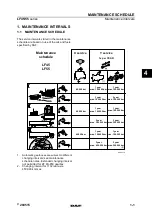
GENERAL INTRODUCTION/SAFETY INSTRUCTIONS AND READINESS TO WORK
1–8
TOWING
•
When being towed, always place the gear shift lever in "Neutral" and release the parking brake completely. In order to
protect the bumper, fit a protection bar against the lower edge of the bumper and put a wood block under the frame near
the No. 1 cross member when attaching the towing chain. Never lift or tow the vehicle if the chain is in direct contact with
the bumper.
1.
Towing procedures
(1)
Make sure that the propeller shaft of the vehicle to be towed is removed. When the differential gear or rear axle
shaft is defective, remove both right and left rear axle shafts, then cover the hub opening to prevent loss of axle
lubricant and entry of dirt or foreign matter.
(2)
Use a heavy duty cable or rope when towing the vehicle. Fasten the cable securely to the towing hook on the
frame.
(3)
The angle of pulling direction of the cable fastened to the towing hook must not exceed 15° in horizontal and ver-
tical directions from the straight ahead, level direction. Avoid using the hook in a way that subjects it to jerk, as in
towing a vehicle trapped in a gutter.
(4)
Keep the gear shift lever in Neutral.
(5)
Make sure that the starter switch is kept in the "ON" position, if the engine is not running.
(6)
Make sure that the engine of the towed vehicle is kept running. If the engine is off, no compressed air/ no vac-
uum will be available for the brake. This is dangerous, as the brake system does not function if the engine is not
running.
In addition, the power steering system will not function. The steering wheel, therefore, will become unusually
hard to turn, making it impossible to control the vehicle.
(7)
Note that the engine brake and exhaust brake cannot be applied, if the propeller shaft is removed.
(8)
Make a slow start to minimize shock. Towing speed should be less than 30 km/h {18 mile/h}.
2.
If the engine of the towed vehicle is defective, make sure that the vehicle is towed only by a tow truck
designed for that purpose.
(1)
Front end towing (with front wheels raised off the ground)
When towing from the front end with the front wheels raised off the ground, remove the rear axle shafts to protect
the transmission and differential gears from being damaged. The hub openings should be covered to prevent the
loss of axle lubricant or the entry of dirt or foreign matter. The above-mentioned precautions should be observed
for vehicles equipped with either manual or automatic transmission, and for even short distance towing. After
being towed, check and refill the rear axle housing with lubricant if necessary.
(2)
Rear end towing
When being towed with the rear wheels raised off the ground, fasten and secure the steering wheel in a straight-
ahead position.

































